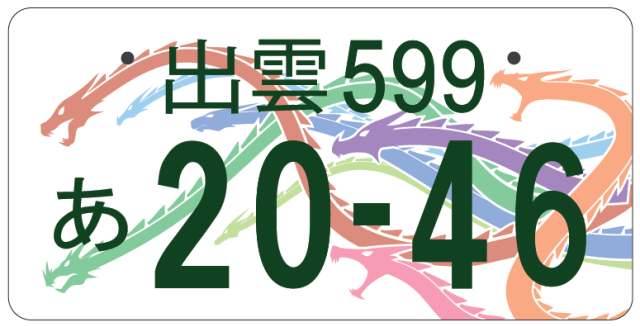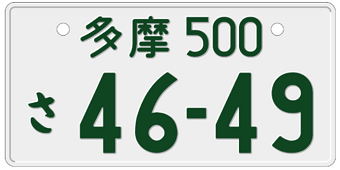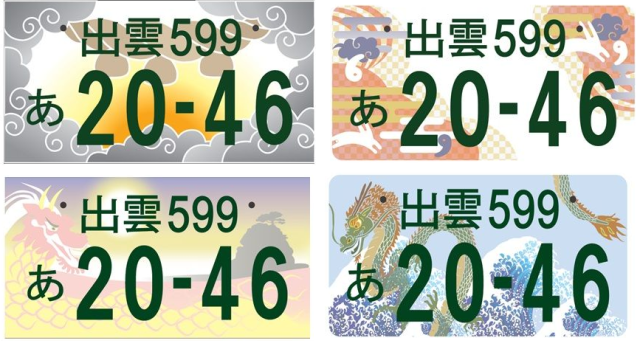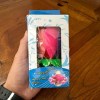
The Yamata no Orochi is ready to leap out of the annals of mythology and onto your car.
Considering that Japan is not only a country with a highly developed sense of aesthetics and plenty of local pride but is also home to a number of the world’s largest carmakers, you might expect the country’s license plates to be stylish, beautiful, or just plain cool. For the most part, though, you’d be wrong, as the vast majority of license plates in Japan, regardless of where your car is registered are just some dark green numerals and text on a plain white background.
▼ Unless you’re a hardcore kanji character linguistics buff, this is about as dull as a license plate can be.
But Japan’s Ministry of Land, Infrastructure and Transport is finally starting to allow designers to mix things up, and they’re making up for lost time in a big way. In the spring, a number of communities unveiled their proposed designs for license plates that salute their local cultural heritage and/or natural scenery, but while they were all lovely, for sheer impact there’s no beating the just-announced upcoming license plate for the town of Izumo.
That’s the Yamata no Orochi, a legendary creature described in the Kojiki, a collection of mythology and folklore written in the 8th century. While the kanji for Orochi, 大蛇, literally translate as “giant snake” or “giant serpent,” the beast is often depicted as a dragon with eight ferocious heads.
Present-day Shimane Prefecture, where Izumo lies, is the setting for the Orochi legend, in which the fearsome dragon is slain by Susanoo, the Shinto god of storms and brother of the sun goddess Amaterasu, and the Orochi design plate was chosen from amongst a number of candidates in a poll to select the look of Izumo’s new license plate. And yes, we’ll save you the trouble of having to tailgate someone and count for yourself by confirming that all eight heads are indeed represented.
▼ A donation is required for the colored version, but the equally cool gray Orochi plate (seen above) can be had free of charge, while the yellow and green-bordered ones are for compact kei and commercial-use vehicles, respectively.
The runners-up were no slouches either, featuring local iconography such as the braided rope of marriage-oriented Izumo Shrine, representing the bond between spouses, and the curved magatama beads also associated with ancient Shinto traditions.
Unlike Japan’s Evangelion, cat pawprint, and woodblock painting license plates, which are all for scooters and other compact conveyances, the Izumo Orochi plates will be for ordinary passenger cars, and are expected to begin being issued in 2020, pending approval by the Ministry of Land, Infrastructure and Transport. Cars owned by residents of Izumo, as well as the nearby towns of Okuizumo and Iinan have the option to display the plates, and while residents do have the option of sticking to the old, boring white and green design, we can’t imagine anyone wanting to pass up this opportunity to have arguably the coolest plates ever.
Source: Izumo City (1, 2) via Japaaan
Top image: Izumo City
Insert images: Izumo City, Wikipedia/BetacommandBot, Izumo City (2)
Follow Casey on Twitter, where he wouldn’t mind front license plate requirements so much if said license plates had dragons on them.





 Adorable mascot bear Kumamon stars on the most popular new license plate in Japan
Adorable mascot bear Kumamon stars on the most popular new license plate in Japan Cherry blossoms are going to bloom on Tokyo’s new license plates
Cherry blossoms are going to bloom on Tokyo’s new license plates 17 new designs unveiled in round two of regional Japanese license plates
17 new designs unveiled in round two of regional Japanese license plates Things to pick up at 7-Eleven: Milk, melon bread, Evangelion sports car
Things to pick up at 7-Eleven: Milk, melon bread, Evangelion sports car In Japan, you can now get issued an official license plate with adorable cat prints on it
In Japan, you can now get issued an official license plate with adorable cat prints on it Foreigner’s request for help in Tokyo makes us sad for the state of society
Foreigner’s request for help in Tokyo makes us sad for the state of society McDonald’s new Happy Meals offer up cute and practical Sanrio lifestyle goods
McDonald’s new Happy Meals offer up cute and practical Sanrio lifestyle goods Red light district sushi restaurant in Tokyo shows us just how wrong we were about it
Red light district sushi restaurant in Tokyo shows us just how wrong we were about it Historical figures get manga makeovers from artists of Spy x Family, My Hero Academia and more
Historical figures get manga makeovers from artists of Spy x Family, My Hero Academia and more Celebrate another year of life by putting it in jeopardy with this birthday candle flower
Celebrate another year of life by putting it in jeopardy with this birthday candle flower Tokyo Tsukiji fish market site to be redeveloped with 50,000-seat stadium, hotel, shopping center
Tokyo Tsukiji fish market site to be redeveloped with 50,000-seat stadium, hotel, shopping center Anime girl English teacher Ellen-sensei becomes VTuber/VVTUber and NFT
Anime girl English teacher Ellen-sensei becomes VTuber/VVTUber and NFT Japan’s massive matcha parfait weighs 6 kilos, contains hidden surprises for anyone who eats it
Japan’s massive matcha parfait weighs 6 kilos, contains hidden surprises for anyone who eats it A Gintama fan’s emotional 19-year journey to buy a proper Lake Toya bokuto wooden katana【Pics】
A Gintama fan’s emotional 19-year journey to buy a proper Lake Toya bokuto wooden katana【Pics】 French Fries Bread in Tokyo’s Shibuya becomes a hit on social media
French Fries Bread in Tokyo’s Shibuya becomes a hit on social media Japanese ramen restaurants under pressure from new yen banknotes
Japanese ramen restaurants under pressure from new yen banknotes All-you-can-drink Starbucks and amazing views part of Tokyo’s new 170 meter-high sky lounge
All-you-can-drink Starbucks and amazing views part of Tokyo’s new 170 meter-high sky lounge Studio Ghibli releases new action figures featuring Nausicaä of the Valley of the Wind characters
Studio Ghibli releases new action figures featuring Nausicaä of the Valley of the Wind characters New private rooms on Tokaido Shinkansen change the way we travel from Tokyo to Kyoto
New private rooms on Tokaido Shinkansen change the way we travel from Tokyo to Kyoto Studio Ghibli glasses cases let anime characters keep an eye on your spectacles
Studio Ghibli glasses cases let anime characters keep an eye on your spectacles Beautiful Ghibli sealing wax kits let you create accessories and elegant letter decorations【Pics】
Beautiful Ghibli sealing wax kits let you create accessories and elegant letter decorations【Pics】 Studio Ghibli releases Kiki’s Delivery Service chocolate cake pouches in Japan
Studio Ghibli releases Kiki’s Delivery Service chocolate cake pouches in Japan New definition of “Japanese whiskey” goes into effect to prevent fakes from fooling overseas buyers
New definition of “Japanese whiskey” goes into effect to prevent fakes from fooling overseas buyers Our Japanese reporter visits Costco in the U.S., finds super American and very Japanese things
Our Japanese reporter visits Costco in the U.S., finds super American and very Japanese things Studio Ghibli unveils Mother’s Day gift set that captures the love in My Neighbour Totoro
Studio Ghibli unveils Mother’s Day gift set that captures the love in My Neighbour Totoro New Japanese KitKat flavour stars Sanrio characters, including Hello Kitty
New Japanese KitKat flavour stars Sanrio characters, including Hello Kitty More foreign tourists than ever before in history visited Japan last month
More foreign tourists than ever before in history visited Japan last month New Pokémon cakes let you eat your way through Pikachu and all the Eevee evolutions
New Pokémon cakes let you eat your way through Pikachu and all the Eevee evolutions Sales of Japan’s most convenient train ticket/shopping payment cards suspended indefinitely
Sales of Japan’s most convenient train ticket/shopping payment cards suspended indefinitely Sold-out Studio Ghibli desktop humidifiers are back so Totoro can help you through the dry season
Sold-out Studio Ghibli desktop humidifiers are back so Totoro can help you through the dry season Japanese government to make first change to romanization spelling rules since the 1950s
Japanese government to make first change to romanization spelling rules since the 1950s Ghibli founders Toshio Suzuki and Hayao Miyazaki contribute to Japanese whisky Totoro label design
Ghibli founders Toshio Suzuki and Hayao Miyazaki contribute to Japanese whisky Totoro label design Doraemon found buried at sea as scene from 1993 anime becomes real life【Photos】
Doraemon found buried at sea as scene from 1993 anime becomes real life【Photos】 Tokyo’s most famous Starbucks is closed
Tokyo’s most famous Starbucks is closed One Piece characters’ nationalities revealed, but fans have mixed opinions
One Piece characters’ nationalities revealed, but fans have mixed opinions We asked a Uniqlo employee what four things we should buy and their suggestions didn’t disappoint
We asked a Uniqlo employee what four things we should buy and their suggestions didn’t disappoint Princesses, fruits, and blacksmiths: Study reveals the 30 most unusual family names in Japan
Princesses, fruits, and blacksmiths: Study reveals the 30 most unusual family names in Japan Izumo’s Starbucks, a stone’s throw away from the gathering place of Shinto’s eight million gods
Izumo’s Starbucks, a stone’s throw away from the gathering place of Shinto’s eight million gods Tokyo’s beautiful new license plates are based on one of Japan’s most famous woodblock paintings
Tokyo’s beautiful new license plates are based on one of Japan’s most famous woodblock paintings Get ready for yuru-kyara car plates! Japan to lift ban on colourful regional license plates
Get ready for yuru-kyara car plates! Japan to lift ban on colourful regional license plates Japanese security polearm maker’s takedown videos are crazy, products look crazy effective【Vids】
Japanese security polearm maker’s takedown videos are crazy, products look crazy effective【Vids】 The surprising reasons why some hiragana aren’t allowed to be used on Japanese license plates
The surprising reasons why some hiragana aren’t allowed to be used on Japanese license plates Five amazing Japanese Starbucks locations that let you keep sightseeing as you take a break
Five amazing Japanese Starbucks locations that let you keep sightseeing as you take a break Japan has too many adorable Akita dog license plate designs, needs help picking just one
Japan has too many adorable Akita dog license plate designs, needs help picking just one City in Nagano offers super cheap taxi fares to seniors who give up licenses and disabled people
City in Nagano offers super cheap taxi fares to seniors who give up licenses and disabled people Toyota’s Prius c Journeys through Dragon Quest and Monster Hunter
Toyota’s Prius c Journeys through Dragon Quest and Monster Hunter Japan’s new manhole cover T-shirts let you show off your local prefectural pride
Japan’s new manhole cover T-shirts let you show off your local prefectural pride Sayonara, crossbows – Police ask owners to turn in their crossbows as new ban goes into effect
Sayonara, crossbows – Police ask owners to turn in their crossbows as new ban goes into effect One in four young people in Japan’s biggest cities thinking of moving to the countryside【Survey】
One in four young people in Japan’s biggest cities thinking of moving to the countryside【Survey】 Thank god: New app rewards prayer with free Wi-Fi
Thank god: New app rewards prayer with free Wi-Fi
Leave a Reply